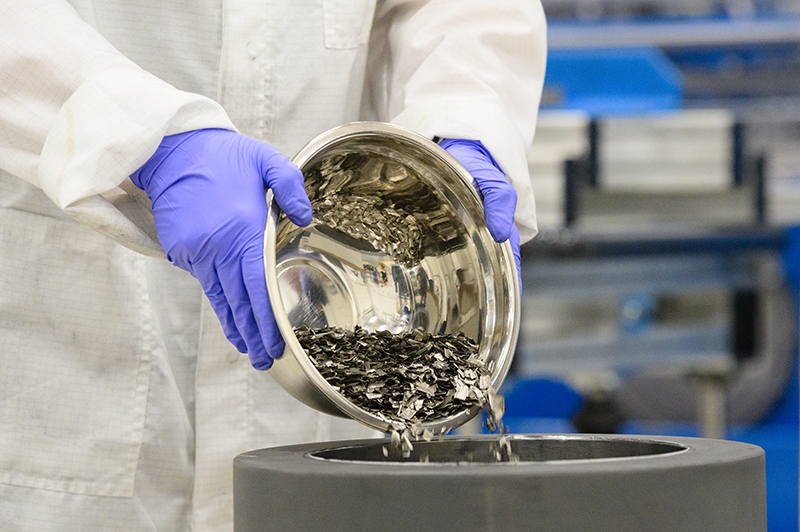FAST-Forge titanium reuse
Titanium offcuts could be reused to form usable raw material using a novel forging process developed at the University of Sheffield, UK.

The Sheffield Titanium Alloy Research group notes that up to 90% of titanium can be machined away, but claims its FAST-Forge method reuses the seemingly useless small offcuts, known as swarf. The technique has been tested at various forging factories.
The researchers have worked closely with Footprint Tools, home to the Henry Royce Institute’s linear forging hammer, with support of the Advanced Forming Research Centre.
Field Assisted Sintering Technology (FAST) uses heat and pressure to form solid objects using any material in particulate form. Dirty titanium turnings are chopped into smaller pieces, cleaned and segregated by size, before being pressed in a mould to make briquettes.
'Stage 1 of FAST-Forge uses reusable graphite dies and tooling to fully consolidate powder/swarf into a shaped billet,' explains Professor Martin Jackson of the University of Sheffield and the Henry Royce Institute. Hydraulic rams apply pressure to compress the die assembly and swarf.
Jackson continues, 'Unlike hot isostatic pressing (HIPing), canning is not required. In HIP, steel cans are time consuming to manufacture and need to be removed after powder consolidation.'
Heating for the forge is provided through pulsed DC current passed through the graphite moulds into the powder feedstock to give thermal energy at temperatures up to 2,200ºC.
As heat and pressure are applied, the swarf particles deform and bond together. As only the powder feedstock is heated, and not the whole vessel as for HIPing, processing times are reported to be 25% that of the equivalent powder charge.
The team claims to be able to produce parts from swarf or powder of any type of morphology and to have equivalent or enhanced mechanical properties compared to conventional forged billet material. 'In fact, ballistic testing of FAST material (without forging) has demonstrated that it exceeds conventional titanium-rolled plate armour,' says Jackson.
Additionally, the closed-loop production process can purportedly continually reuse waste byproducts to create new, high-specification items.
'Titanium is an aerospace material, but due to wastage, for every 10kg of material we import, only 1kg ends up in the air. So in order to counteract this, at the University of Sheffield, we have developed a solid-state recycling process,' adds Jackson.
David Lunn, of Wolverhampton-based forgers, W.H. Tildesley, reports that FAST-Forged titanium extends the use of its moulds from 200-300 uses to more than 1,000, increasing part life by at least 300%.
The increase in machining life, decreased maintenance, ease of forging and reduced heating makes the FAST-Forge cheaper and more energy efficient, says the Sheffield team.
Moreover, by testing the process on industry-standard and scalable equipment on factory floors, they have yielded more data than a purely research-based set-up.
Due to the variety and number of different companies that the University is working with – from aerospace and oil to biomedical and nuclear – Jackson envisages strong demand.







